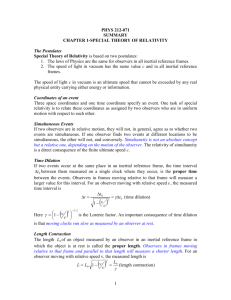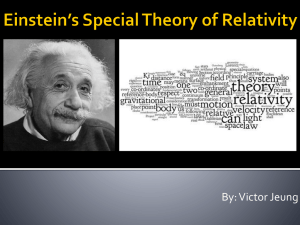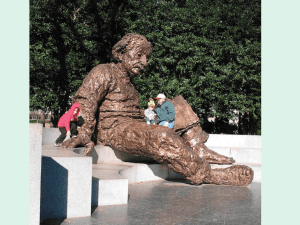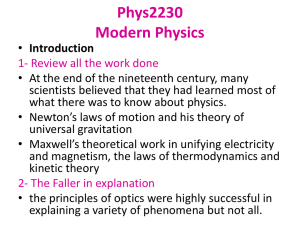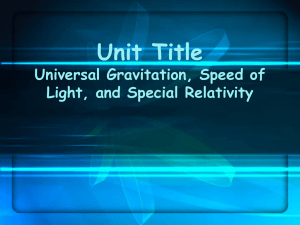Unit 5 Study Questions Key
advertisement
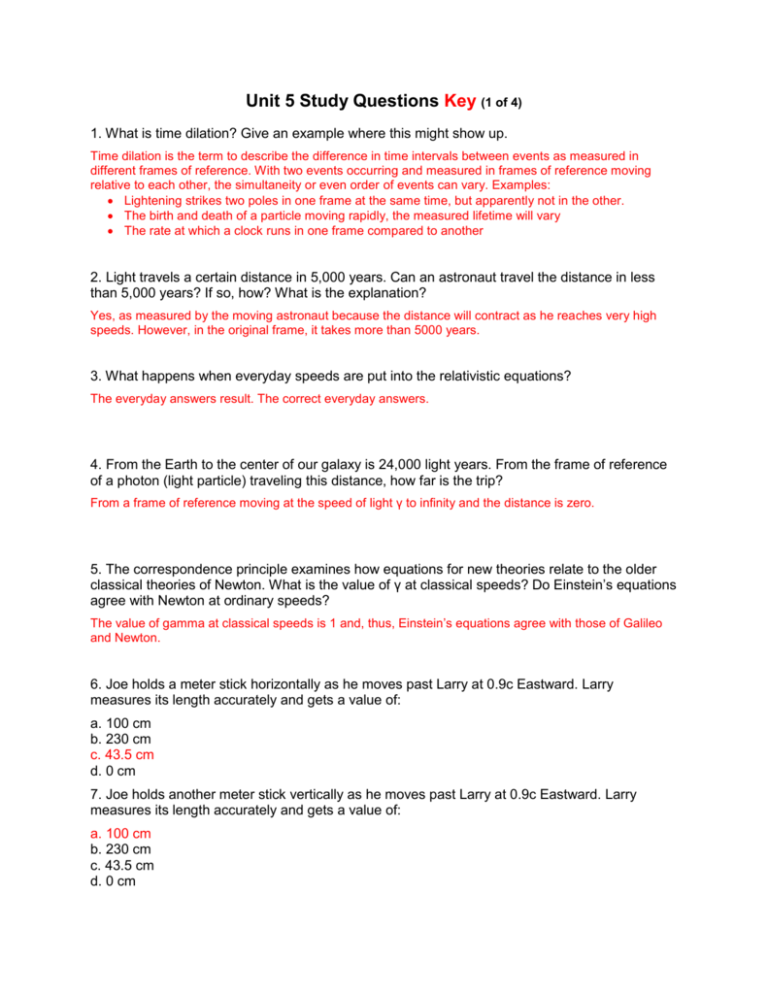
Unit 5 Study Questions Key (1 of 4) 1. What is time dilation? Give an example where this might show up. Time dilation is the term to describe the difference in time intervals between events as measured in different frames of reference. With two events occurring and measured in frames of reference moving relative to each other, the simultaneity or even order of events can vary. Examples: Lightening strikes two poles in one frame at the same time, but apparently not in the other. The birth and death of a particle moving rapidly, the measured lifetime will vary The rate at which a clock runs in one frame compared to another 2. Light travels a certain distance in 5,000 years. Can an astronaut travel the distance in less than 5,000 years? If so, how? What is the explanation? Yes, as measured by the moving astronaut because the distance will contract as he reaches very high speeds. However, in the original frame, it takes more than 5000 years. 3. What happens when everyday speeds are put into the relativistic equations? The everyday answers result. The correct everyday answers. 4. From the Earth to the center of our galaxy is 24,000 light years. From the frame of reference of a photon (light particle) traveling this distance, how far is the trip? From a frame of reference moving at the speed of light γ to infinity and the distance is zero. 5. The correspondence principle examines how equations for new theories relate to the older classical theories of Newton. What is the value of γ at classical speeds? Do Einstein’s equations agree with Newton at ordinary speeds? The value of gamma at classical speeds is 1 and, thus, Einstein’s equations agree with those of Galileo and Newton. 6. Joe holds a meter stick horizontally as he moves past Larry at 0.9c Eastward. Larry measures its length accurately and gets a value of: a. 100 cm b. 230 cm c. 43.5 cm d. 0 cm 7. Joe holds another meter stick vertically as he moves past Larry at 0.9c Eastward. Larry measures its length accurately and gets a value of: a. 100 cm b. 230 cm c. 43.5 cm d. 0 cm Unit 5 Study Questions Key (2 of 4) 8. In the meantime, Joe measures the meter stick that Larry is holding horizontally to be of length a. 100 cm b. 230 cm c. 43.5 cm d. 0 cm 9. Using special relativity concepts, one can imagine (in a sense) visiting the future but not going backward in time. Explain. The idea is that if you travel very fast, you age more slowly. Thus, if you did a very fast trip, you might age a few years but end up many years in other people’s future. You would not go back in time using special relativity, and frankly the return trip for this scenario involved general relativity. Perhaps worm holes or some other exotic plan. 10. A train is traveling east at 50 m/sec past a boy on the side of the tracks. A girl throws a ball to the boy at essentially a speed of zero as the train passes. What is the velocity of the ball relative to the girl? a. 0 m/sec b. 50 m/sec east c. 50 m/sec west d. the speed of light west 11. A train moving at 0.8c past an observer on the ground emits a flash of light at the midpoint of the train as marked on the train. This occurs at the exact moment that the midpoint of the train passes the observer on the ground. When the light hits the ends of the train, flags pop up to mark its arrival. Give the time order of the events as measured by the observer on the ground and by an observer on the train. To an observer on the train, the light travels to the ends of the train at the same time and the flags pop at the same time. To an observer on the ground the farther away flag (the front of the train) will pop last and the near flag will pop first. 12. Which of the following are invariant to transformation between inertial frames according to special relativity? (may be more than one) a. laws of physics b. speed of light c. order in which events happen d. mass of an electron 13. Explain what is “special” about special relativity and how general relativity more is general. The special frames of reference must be inertial. General relativity is not restricted to inertial frames. Special relativity is sometimes called restricted relativity. Unit 5 Study Questions Key (3 of 4) 14. We imagine three space ships. We are at rest in ship C with ship A moving to our right at .9c and ship B moving to our left at .9c. What speed does ship A measure the speed of ship B? a. .9c b. 1.8 c c. c d. .994c 15. In the situation of question 14, what does ship C measure the speed of the laser beam from ship A? a. .9c b. 1.9c c. c d. .994c 16. In the situation of question 14, what does ship B measure the speed of the laser beam from ship A? a. .9c b. 1.9c c. c d. .994c 17. A particle is moving at .99c and more and more kinetic energy is given to the particle. What is the major effect of increasing the kinetic energy of the particle? a. increased speed b. increased mass c. decreasing its mass d. dragging more ether with it 18. If Newton’s laws have been proven to be wrong and Einstein’s equations are correct, why do we not use Einstein’s for all of the problems and throw away Newton’s laws? Einstein’s equations are more difficult to use and are only necessary to use at high relative velocities. 19. Two rocket ships are each traveling at 0.5c. Ship A is going toward the Earth and ship B is going away from the Earth. They both send messages at the same time. Which message reaches the Earth first? a. Ship A b. Ship B c. the messages arrive at the same time 20. A space ship moving to the right at 0.5c shines a light forward and another light backward. Which beam of light moves faster? Explain? Both the same. The speed of light is the constant regardless of the conditions – as measured in an inertial frame of reference. Unit 5 Study Questions Key (4 of 4) 21. The concept that mass cannot be created nor destroyed has been modified by special relativity. How should it now be stated? The conservation principle now states that mass-energy is conserved. Mass and energy are the same thing. 22. The gravitational field strength at the Earth’s surface is 9.8 m/sec2. What is the field strength at the center of the Earth? What is the field strength at a distance one Earth radius beyond the surface? At the center, the radius is zero, which is scary but there is no mass inside the zero radius. The field is zero at the center. At one radius out from the surface you are at twice the normal distance which makes the field ¼ the original or 2.45 m/s2. 23. The mass of a black hole is no more than the mass of the star from which it was made (collapsed). Why then is the gravitation so intense near a black hole? The same mass with a much smaller radius produces a much stronger gravitational field near the surface. 24. The Earth has a slight bulge at the equator, thus the distance from the center is slightly more than at the poles. The gravity felt at the equator will be _________ at the poles. a. slightly less than b. slightly more than c. the same as 25. Assume that the Earth did not spin on its axis. According to general relativity, a clock at the equator would then run _______ one at the poles. a. faster than b. slower than c. the same as 26. Satellites in lower orbits ________ higher orbits. a. move faster and take less time to orbit than in b. move slower but take the same time to orbit as in c. have more gravity thus move slower than in d. move at the same speed as in
